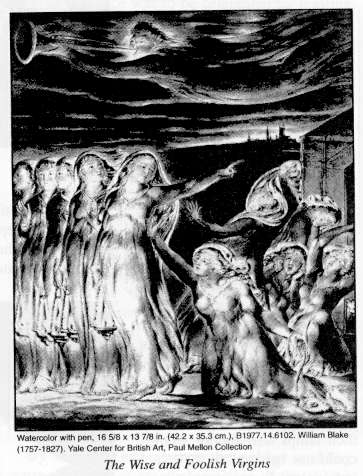
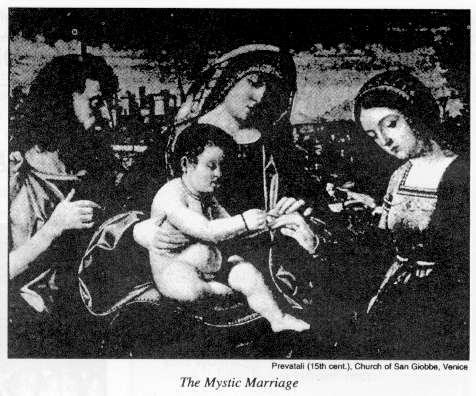
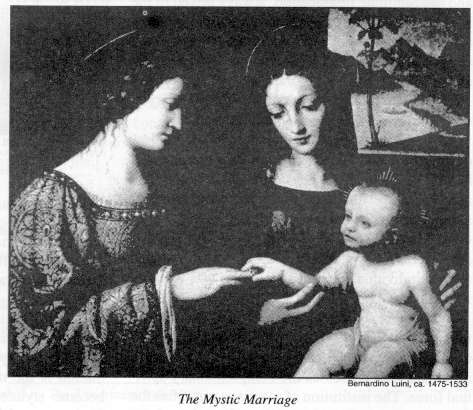
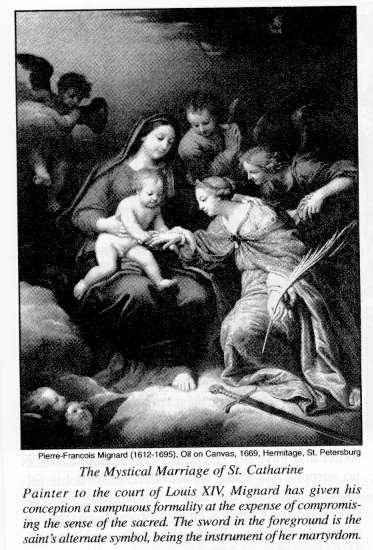
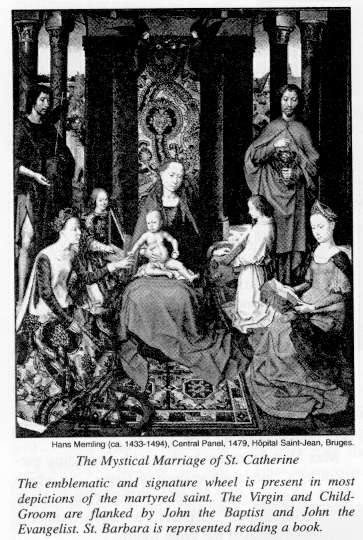
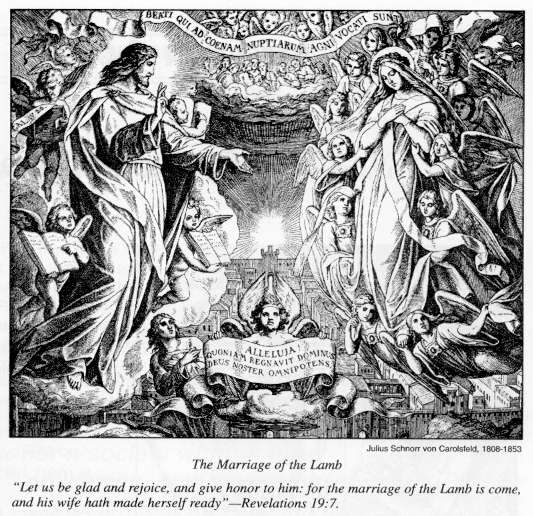
| rosanista.com | ||
| Simplified Scientific Christianity |






I am my Love's and he is mine,
And this is his desire,
That with his beauty I may shine
In radiant attire.
And this will be when all of me
Is pruned and purged with fire.
— Canticles 7:10
Humans have always been spiritual hermaphrodites, the bisexual ego containing within itself both the faculties of masculine will, allied with the Sun forces, and the feminine imagination, always linked to the Moon forces. But due to evolutionary needs incident to incarnation, procreative autonomy was divided to enable half the available creative force to build and specialize a physical brain to comprehend and gain mastery over the material world, and a larynx to give expression to sense-related thinking.
Prior to the separation into physical genders during the Lemurian epoch, humans were physical hermaphrodites. But they were also "brainless" automatons perfectly reflecting the will and guidance of their spiritual supervisors. However, due to the ultimately beneficial influence of the class of angels collectively known as Lucifers, an impulse toward individualism and separatism was instilled in involving man.
Brain consciousness of the external world has thus been obtained at the cost of losing the ability to singly procreate, necessitating the cooperation of a mate who possesses the complementary spiritual force. The institution of marriage sanctifies the male-female bond in which generation takes place.
Yet marriage is but an outward and visible sign of an inward, occult eventuality: the regaining of physical (etheric) wholeness. It is this prospect that is implicit in the term "mystic marriage," which refers to the attainment of those who "neither marry nor are given in marriage, but are as the angels of God in heaven" — (Matt. 22:30).
In the Christian tradition, an idea that has served as a particularly fertile subject for the artistic imagination is the mystic marriage, which, over time, became stylized as a depiction of the bride of Christ, named Catharine, meaning "the pure one," proffering her hand to be ringed by the infant Christ (Jesus) Child. Such a popular representation conveyed more esoteric truth and profundity than most artists or viewers consciously realized.
The inspiration and material for this visual image has its authoritative source in both Christian gospels and Pauline epistles. The marriage is mystic because it is physically invisible. The bride of Christ is, variously, the chaste physical body, the purified desire body, or the composite soul. The groom is, also variously, the Christed (enhanced light and reflecting) ether-soul Life; the Christed desire body-soul Light; Christed thought-the mind of Christ; or Christed will-Christ Love.
In Matthew, chapter 25, the (etheric) Kingdom of Heaven is likened to ten virgins "which took their lamps and went forth to meet the bridegroom." Five of them were wise, for they had oil (golden light ether) in their lamps (physical bodies), and five of them were foolish, for their lamps were empty, so they could not "go out" in their soul (etheric) bodies to see and meet the groom, the etheric Christ, for they had no light.
Again in Matthew, chapter 22, the (etheric) Kingdom of Heaven (the New Jerusalem) is likened unto a king (God the Father) who made a marriage for his son (Christ) and sent forth servants (prophets) to call them that were bid (at first, the original Semites). The new servants are those intuitions urging each Ego to make ready for the soul's wedding by preparing the wedding or etheric garment of light wherein only may they gain admission to the Kingdom of Light. Max Heindel translates this wedding parable into unambiguous language and a pointed message: "Unless we really work and serve humanity, we shall have nothing to bring, no bread to 'shew' at the Feast of the Full Moon; and at the mystic marriage of the higher to the lower self, we shall find ourselves minus the radiant golden soul body, the mystic wedding garment without which the union with Christ can never be consummated" (Ancient and Modern Initiation).
The crux of the apostle Paul's ministry was to make known the fruits of the mystic marriage, the attainment of spiritual wholeness, "a perfect man...the measure of the stature of the fullness of Christ" (Eph. 4:13). The means of attainment was the same as the goal: "Put ye on the Lord Jesus Christ" (Rom. 13:14), the incorruptible body of light (Paul's soma psuchicon) which the aspirant weaves, thread by golden thread, deed by selfless deed. We groan in our earthly tent, "earnestly desiring to be clothed with our habitation which is from heaven" — (2 Cor. 5:2).
Paul addresses fellow Christians by employing the metaphor of matrimony: "I have espoused you to one husband, that I may present you as a chaste virgin to Christ" (2 Cor. 2:2). Or, "my brethren, ye should be married to another, even to him who is raised from the dead, that we should bring forth fruit unto God" (Rom. 7:14). And Christ Jesus referred to Himself as the Bridegroom (Luke 5:34-5) Whose presence was to be celebrated by feasting, not fasting.
If Christ is the Bridegroom, who is the bride? Both the church or ecclesia of believers and the individual spiritualized soul, denominating a macrocosmic and a microcosmic marriage, respectively. When a man is joined unto his wife, "they two shall be one flesh. This is a great mystery: but I speak concerning Christ and the Church" (Eph. 5:31-2). Christ is "the head of the body, the Church" (Col. 1 :18), or, as Paul writes to the Corinthians, "you are the body of Christ and members individually" — (1 Cor. 12:27).
Max Heindel refers to the golden wedding garment as a "luminous vesture of flame" "in which those who are 'the bride' will meet their Lord when He comes" — (IIQ&A, p. 309). Angelus Silesius often used the same figure:
Child, be the bride of God,
And be thou His alone.
Thou shalt His sweetheart be,
As He's thy lover grown.
By sacrifice and service the golden wedding garment forms as an amalgamation of the golden substance "emanated from and by the Spirit of the Sun, the Cosmic Christ," which, when of sufficient density, shall enable us "to imitate the Easter Sun and soar into the higher spheres" (Gleanings of a Mystic, p. 165). The wedding garment in Revelations is also called the white stone, the hidden manna, the tree of life, the morning star, white raiment, and gold tried in the fire.
"The mystic marriage of the lower self to the higher, the immaculate conception, and the divine motherhood which nourishes 'the new born Christ' deep in its bosom, unseen by a scoffing world, are actual experiences of a growing number of people" (Message of the Stars).
John the Baptist sees Jesus and says, "Behold the Lamb of God." In Revelations the voice of mighty thunderings says, "the marriage of the Lamb is come, and his wife hath made herself ready...Blessed are they which are called unto the marriage supper of the Lamb." Max Heindel explains, "There is that marriage in every soul's experience, and always under similar circumstances. One of the first requisites is that the soul must have been forsaken by everyone else: it must stand alone without a single friend in the world. When that point has been attained, when the soul sees no succor from any earthly source, when it turns with its whole heart to heaven and prays for deliverance, then comes the deliverer and also the offer of marriage. In other words, the true Teacher always comes in response to the earnest prayers of the aspirant" (Mysteries of the Great Operas).
The spiritual and esoteric meaning of the mystic marriage became crystallized around the name of Catharine, as in the sense of catharsis (to purify) and Cathari (the religiously pure). St. Catharine of Alexandria was the original "bride of Christ," but the devout and rightly proud people of medieval Siena also made this claim for their Catharine, who did not fail to impress her contemporaries with her extraordinary powers as a saint. She joined the Dominican Order in which, solely because of her sanctity and in spite of her lack of culture, she played a prominent part in the historical events of her age. Popular belief naturally ascribed to her all the honors of her namesake of Alexandria, and her mystic marriage has been pictured by numerous Umbrian and other painters. Max Heindel writes (A&MI, p. 119) that both Dominicans and Francis-cans attest to her having received the stigmata.
The near-formula portrayal of St. Catharine depicts the infant Christ placing the ring of betrothal on her finger. Once, she said, when she was fasting and praying, Christ Himself appeared to her and gave her His heart. This should come as no surprise. As Paul, an occultist, exhorts his fellows to cultivate the all-comprehending mind of Christ, so the Catholic church urges its charges on the mystic path to develop the soft, sensitive, all-embracing heart of Christ.
Ultimately, Catharine is a representation of the chaste soul which has both wedded the Christ Spirit and given mystic birth to the Christ Child. The original Catharine of Alexandria is a semi-historical figure who is revered by the church as the patron of philosophy, science, and language. She is the tutelary saint of the University of Paris. According to the Roman Breviary for November 25, the Saint's day, she was a noble maiden, distinguished in all virtue, especially wisdom and moral purity. She attained such a height of holiness and learning that by age eighteen none could best her in logic or persuasion. But when she protested the torture and death of Christians at the hand of King Maxentius, rebuking him for his cruelty, he sought the most learned men of the day to confute her and vindicate his practice of worshiping idols. These sages, however, were overcome by her keen intellect and piety, and the love of Jesus Christ was kindled in them. Maxentius, outraged, had Catharine flailed with leaden whips and then bound to a wheel set with numerous sharp blades. But as she prayed, the wheel was shattered and so Maxentius had her beheaded. Tradition tells of her body being laid on Mount Sinai by angels. The wheel associates Catharine with the Solar Christ and she is frequently depicted wearing either a wheel brooch or star-wheel-patterned raiment.
The marriage of St. Catharine to Christ was the subject for a remarkably large number of painters, including Carlo Crivelli, Albrecht Durer, Jan Van Eyck, Pinturicchio, Raphael, Hans Memling, Fra Angelico, Bernardino Luini, Andrea del Sarto, Ghirlandajo, Fra Bartolommeo, Borgognone, Paul Veronese, Parmigianino, Correggio, Murillo, and Tintoretto. Obviously, more was intimated in these representations than meets the eye. They satisfied the deep surmise in their viewer that a special union could and does take place between the Christ and the pure and devoted soul.
Max Heindel reminds us that the mystic wedding is neither a fantasty of sublimated eroticism nor a unique occurrence. "All who are upon the Path, whether the path of occultism or mysticism, are weaving the 'golden wedding garment'" by both inner alchemical work, as detailed in The Chemical Wedding of Christian Rosenkreutz, and by outer service, whereby they transmute the body into the ruby soul, the red Philosopher's Stone, or the white Philosopher's Stone, the diamond soul. Eventually, when the aspirant nears completion of the process of transfiguration, the body transfigured by the Christ Light will have the uniform color corresponding to the pink color seen by occultists as the Spiritual Sun, the vehicle of the Father (A&MI). How, then, do we prepare for and bring about the mystic marriage? Let one who knows tell us: "The sooner we learn to see in ourselves a whole creative unit, the more we preserve our own creative force, and send it upward for spiritual purposes, the sooner we shall find the man or woman within ourselves. The mystic marriage will then have been performed."
"Thus by degrees the man finds the finer feminine qualities in himself, and the woman finds the noblest traits of the man. When that point has come where there is a perfect balance, the mystic marriage takes place." (IIQ&A).
"And the Spirit and the bride say, come. And let him who hears say, come...Even so, come, Lord Jesus."
— C.W.
— Rays from the Rose Cross Magazine, January/February, 1996
|
Contemporary Mystic Christianity |
|
|
This web page has been edited and/or excerpted from reference material, has been modified from it's original version, and is in conformance with the web host's Members Terms & Conditions. This website is offered to the public by students of The Rosicrucian Teachings, and has no official affiliation with any organization. | Mobile Version | |
|